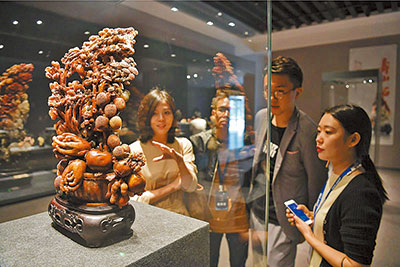
Cao Zhen caozhen0806@126.com CARVED stones have long been favored by collectors due to their austere origins and exquisite craftsmanship. Han Wangxi, director of the Information Office of Shenzhen Municipal Government, who is also an established cultural scholar, believes that real admiration for the stones should be focused on China’s ancient and refined stone culture rather than mere beauty. On Sunday, at the closing of a stone sculpture exhibition at Guofeng Art Museum in Longgang District, Han explained that in traditional Chinese culture, stones and jade have had different symbolic meanings. “Stone retains its natural and primitively true features, while jade is carved and polished. Stones carry all the secrets of the world and have the most natural beauty, while jade represents human civilization. Jade comes from stone, but in an ancient civilized society, jade symbolized political order and social status,” said Han. “Due to the contrast, stone was imbued with an independent, original and unique spirit in ancient Chinese culture, while jade represented achievements and cultivation,” he added. Guofeng’s exhibition featured more than 600 stone sculptures from Shoushan (Fujian Province), Changhua (Zhejiang Province), Balin (Inner Mongolia Autonomous Region) and Qingtian (Zhejiang Province). Known as the “Four Famous Stones in China,” each of the four rare types of stone is valuable in the gem trade due to their rarity and incredible beauty. They are often carved into prestigious seals and sculptures. During the exhibition, experienced craftsmen from around the country offered several free talks to locals on how to admire stones. “Raw stones on the mountain have diverse colors and textures — some are transparent and some are solid red, which give much space for creation,” said craftsman Liu Zhou. White and yellow jelly-like stones are semi-translucent and glittering. Bright crimson stones, commonly called “chicken-blood stones,” are favored by collectors because in an un-carved state they are often valued at hundreds of millions of yuan. During the Ming Dynasty (1368-1644), nobles and refined scholars started to collect chicken-blood stones to use as seals. During the Qing Dynasty (1644-1911), emperors and their concubines all chose chicken-blood stones as their seal stones. “China’s stone culture is extensive and profound, so craftsmen should show respect for the stones’ nature and reveal the beauty in them,” said Liu. | 
